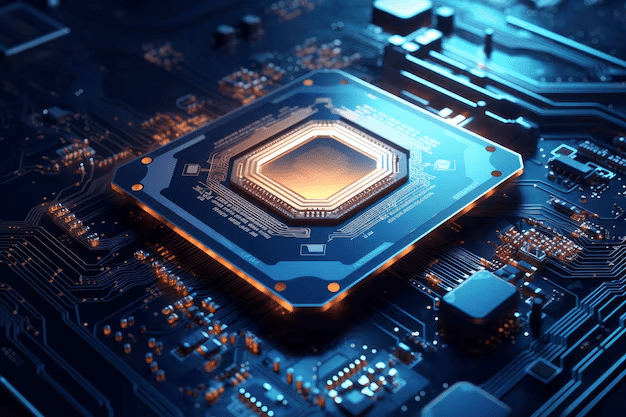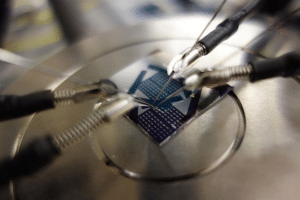
Electron Beam Evaporation Coating (EB-PVD) process and advantages

E-beam evaporation is a surface coating technology based on an electron beam heat source and belongs to thePhysical vapor depositionThe principle is simple and effective. In this process, a high-energy electron beam is focused onto the surface of the material to be evaporated, heating the material locally through energy transfer and thus causing it to evaporate into a gaseous state. The gaseous material is then deposited onto the target substrate in a vacuum environment to form a thin film. This process is highly controllable and reproducible, enabling precise tuning of the film thickness, composition and structure.
Equipment Components for EB-PVD Technology
The principle of E-beam Evaporation Coating is based on energy transfer and material evaporation by an electron beam. In this process, the material is heated to a high enough temperature through the use of an electron beam heat source that it is directly transformed from a solid state to a gaseous state and then deposited on the target substrate to form a thin film.
Vacuum system: This consists of a vacuum chamber, vacuum pumps and associated piping to ensure that the deposition process takes place in a high vacuum environment, typically in the range of 10^-5 to 10^-7 torr.
Electron Beam Source: Generates a high-energy electron beam that is focused and scanned by an electromagnetic lens system that controls the energy and position of the beam.
Target: Material, usually a metal, alloy or compound, that is heated and vaporized by the electron beam.
Substrate Table: Used to hold and heat the substrate, which can be rotated or tilted to improve film uniformity.
Control system: including electron beam power control, substrate heating control and vacuum system control.
Process steps for EB-PVD technology
- Substrate cleaning
- Loading substrates
- Preliminary evacuation
- High vacuum pumping
- Electron beam heating
- Target evaporation
- steam transport
- Thin Film Formation
- Thickness Monitoring
- Deposition rate control
- Cooling substrates
- Remove the substrate
Advantages of EB-PVD technology
High deposition rate
- High efficiency: high energy density of the electron beam and fast evaporation of the target material can realize high deposition rate, which is suitable for large area and thick film deposition.
High Purity Film
- Vacuum environment: Deposition is carried out in a high vacuum environment, which effectively reduces impurities and contamination and ensures the high purity of the film.
- Pure material source: The use of high purity targets further improves the purity and quality of the film.
Precise control
- Thickness and composition: By adjusting the electron beam power, scanning speed and substrate temperature, the thickness and composition of the film can be precisely controlled.
- Uniformity: E-beam scanning technology enables uniform deposition on the surface of the substrate, ensuring consistent film thickness.
Suitable for a wide range of materials
- Versatile targets: EB-PVD technology can process a wide range of materials, including metals, alloys, oxides, carbides and nitrides, and is highly adaptable.
- Composites: Deposition of composites can be achieved by co-evaporation or multi-source evaporation to prepare thin films with special properties.
High quality film
- High densification: The deposited film has a dense, non-porous structure with excellent mechanical properties and durability.
- Strong adhesion: Strong adhesion between film and substrate for high stress and high temperature environments.
High temperature deposition capability
- High Temperature Resistance: EB-PVD is capable of deposition in high temperature environments and is suitable for the manufacture of high temperature resistant materials such as thermal barrier coatings (TBCs).
- High-temperature stability: the deposited film has good stability at high temperatures and is not easy to oxidize or decompose.
low damage
- Substrate protection: Since the electron beam heating is mainly concentrated on the target material, the thermal effect on the substrate is small, and it is suitable for thin film deposition of heat-sensitive materials.
Process Flexibility
- Adjustable process parameters: Electron beam power, scanning mode, substrate temperature and other process parameters can be adjusted to meet different application requirements.
- Multi-functional application: Multi-layer film and gradient film deposition can be realized to meet different functional and performance requirements.
Environmental and economic
- Environmentally friendly: The high vacuum environment reduces the use and emission of harmful gases and is relatively environmentally friendly.
- Cost-effectiveness: Although the initial investment in the equipment is high, the high efficiency and quality of the deposition process reduces the cost of use in the long term.
vaporizable material
Aluminum (Al), copper (Cu), titanium (Ti), nickel (Ni), chromium (Cr), gold (Au,) silver (Ag), tungsten (W), indium tin oxide (ITO), titanium oxide (TiO2), aluminum oxide (Al2O3), zinc oxide (ZnO), hafnium oxide (HfO2), titanium carbide (TiC), silicon carbide (SiC), titanium nitride (TiN), silicon nitride (Si3N4), aluminum nitride (AlN), titanium boride (TiB2), titanium silicide (TiSi2), carbon (C) and so on. Si3N4), aluminum nitride (AlN), titanium boride (TiB2), titanium silicide (TiSi2), carbon (C) and so on.
We offer Electron Beam Evaporation Deposition (EB-PVD) OEM Customization Services, Feel free to leave a message to inquire.
Difference between ICPCVD and PECVD preparation of silicon nitride films
Difference between ICPCVD and PECVD preparation of silicon nitride films IC
Silicon Nitride (SiNx) Thin Films for Optical Applications
Silicon Nitride Thin Film in Optics Silicon nitride thin film as a canonical
Electron Beam Evaporation Coating (EB-PVD) Processes and Advantages and Disadvantages
Processes and Advantages of Electron Beam Evaporation Coating (EB-PVD) Electron Beam



.jpg)